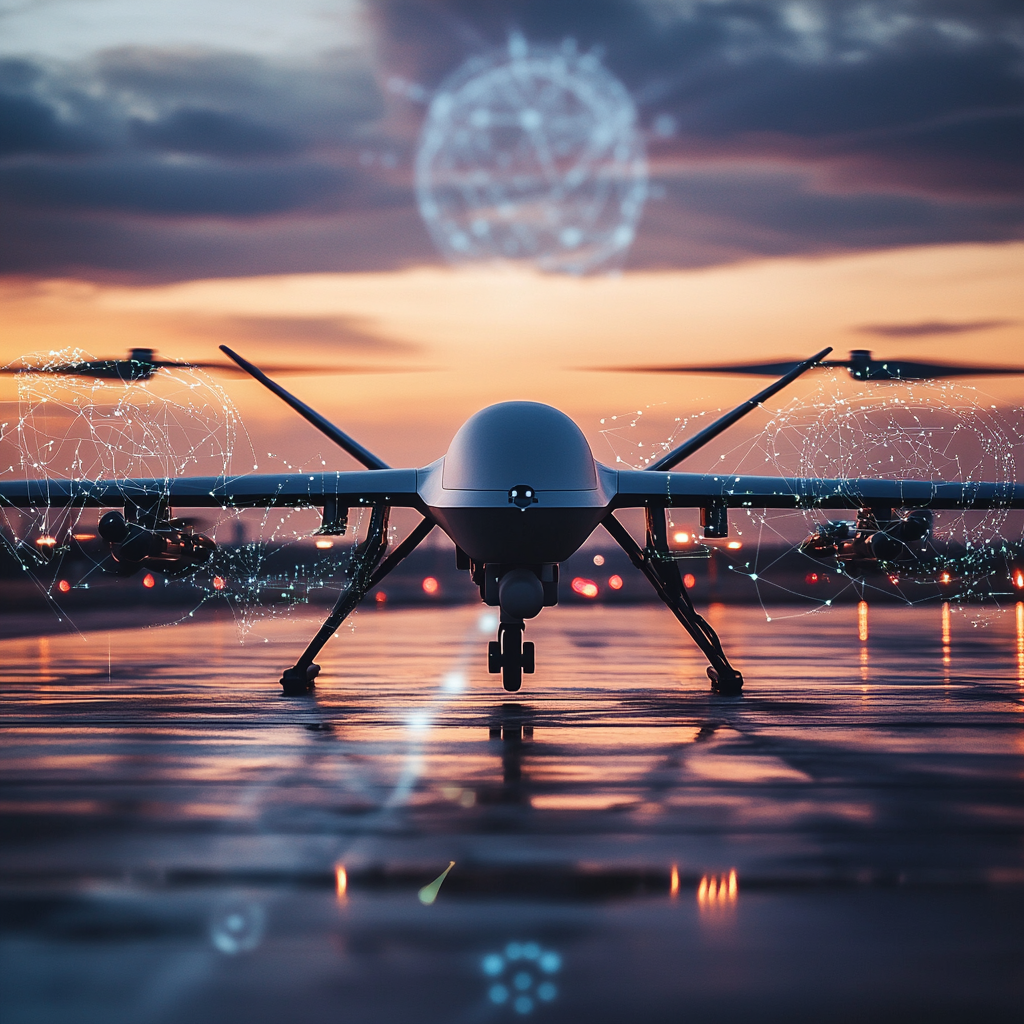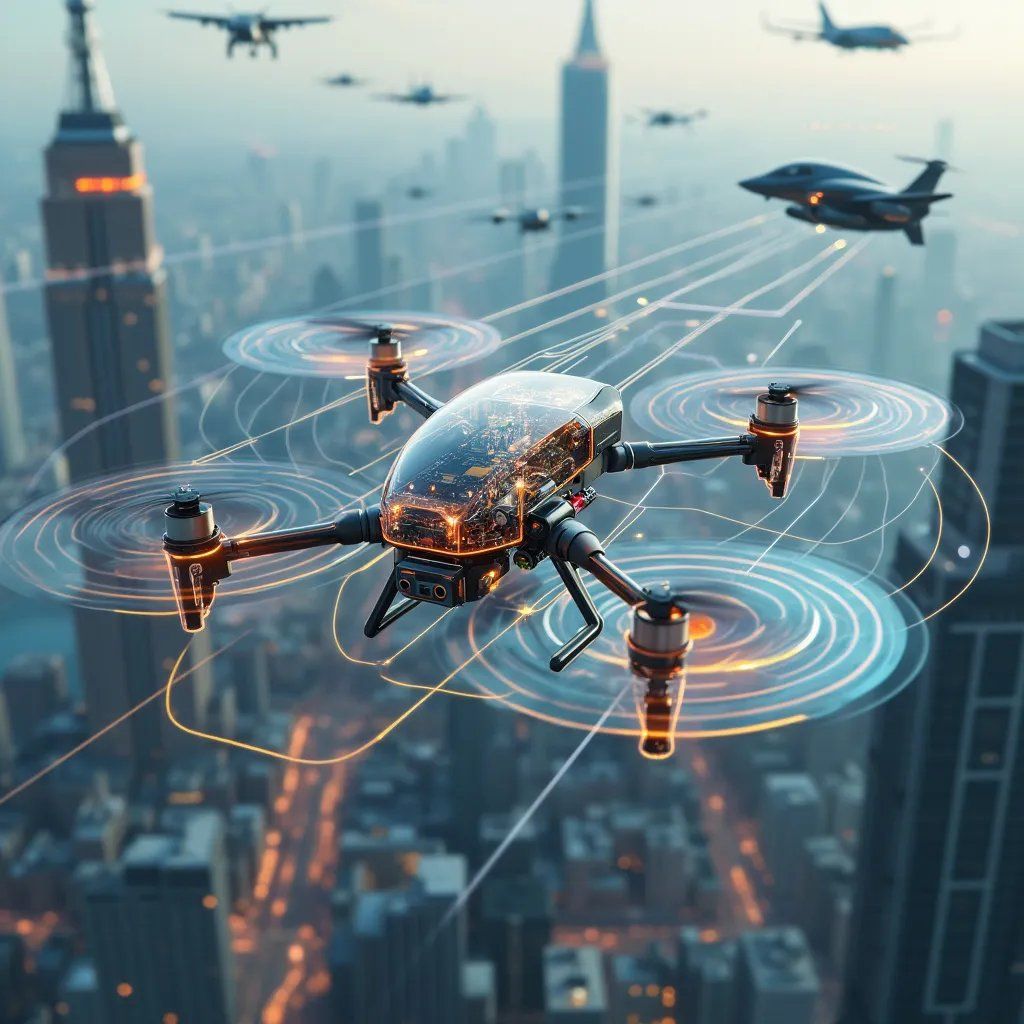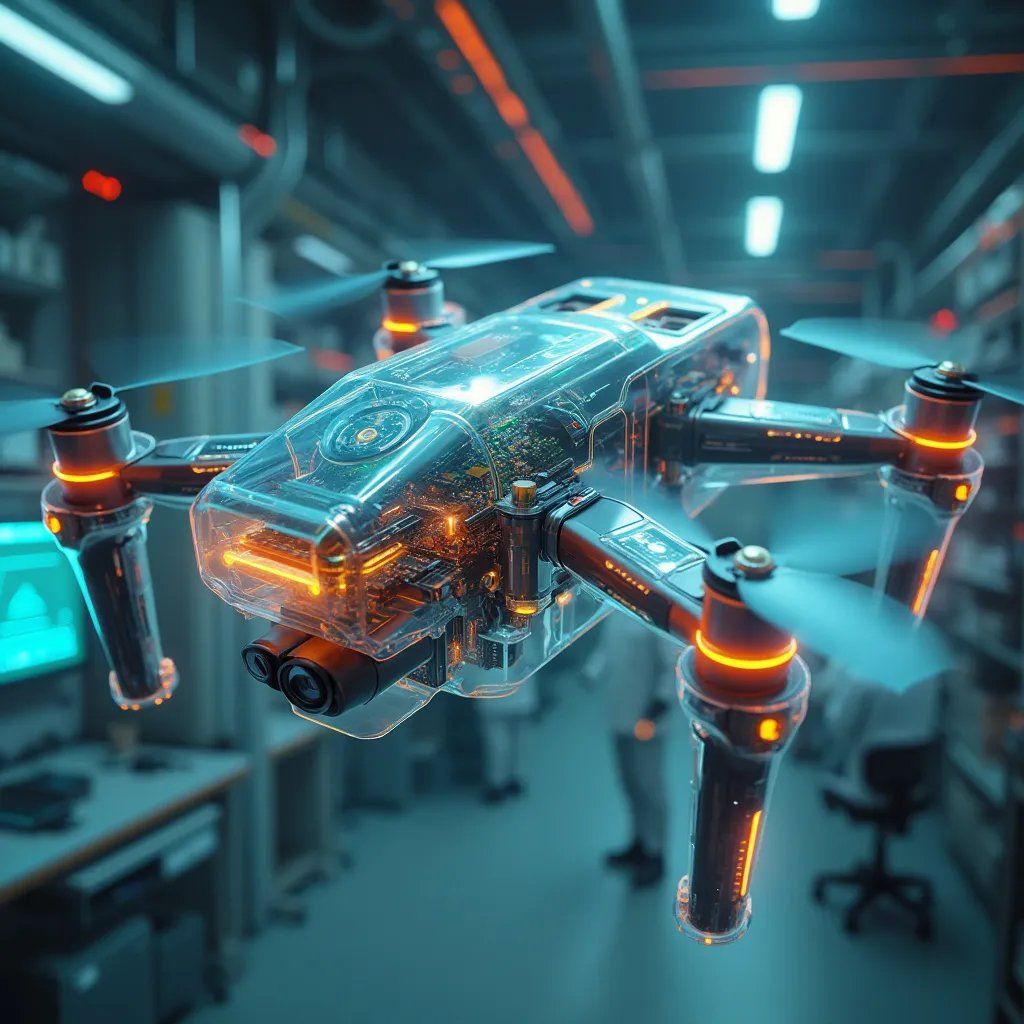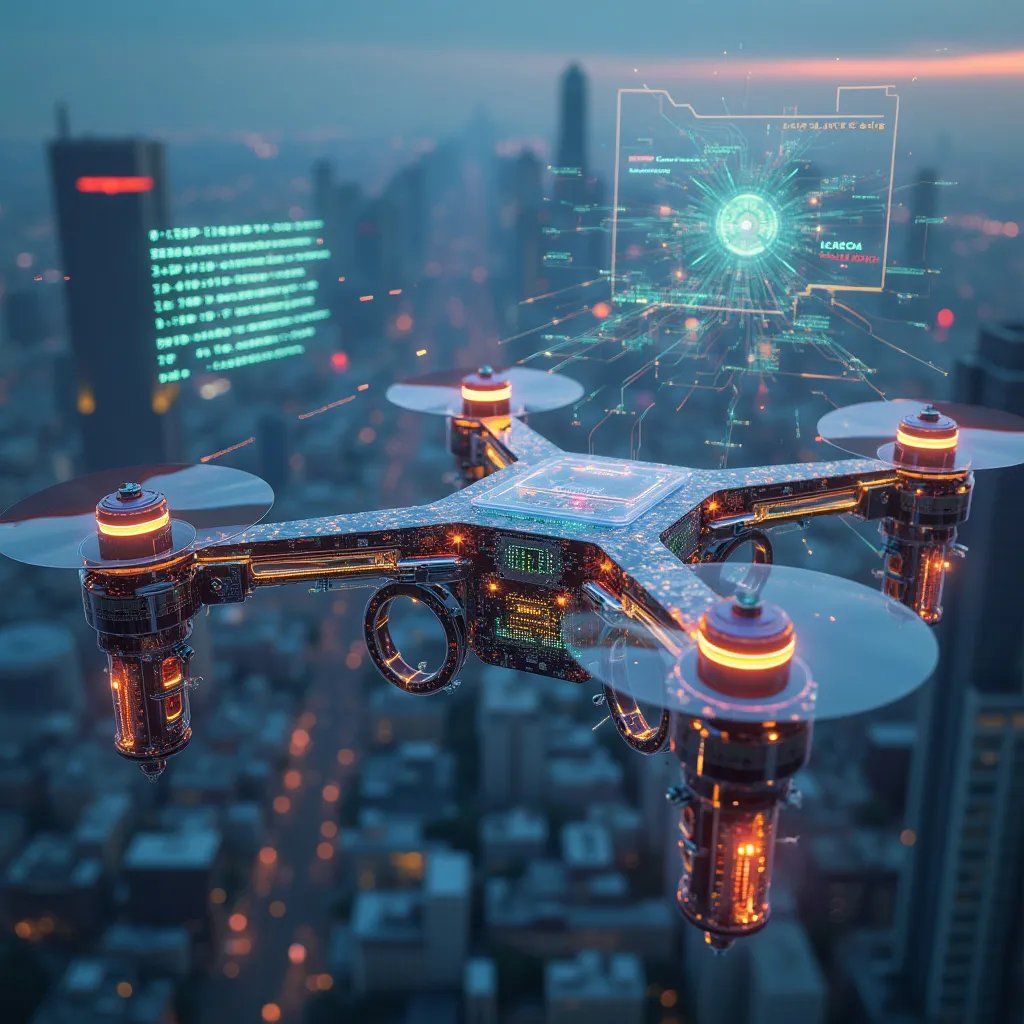Introduction
The rapid proliferation of unmanned aerial vehicles (UAVs) or drones in both military and civilian sectors has brought about new challenges in security and authentication. As drones become increasingly integrated into our airspace and daily operations, the need for robust, secure, and efficient authentication mechanisms has never been more critical. Enter blockchain technology – a revolutionary approach to data management and security that’s finding innovative applications in drone authentication systems.
This article explores the cutting-edge intersection of blockchain technology and drone authentication, highlighting how this combination is reshaping the landscape of drone security and opening up new possibilities for secure, decentralized drone operations.
The Need for Advanced Drone Authentication
Current Challenges in Drone Identification
Traditional drone identification and authentication methods face several challenges:
- Centralized Vulnerability: Conventional systems often rely on centralized databases, creating single points of failure and attractive targets for cyberattacks.
- Scalability Issues: As the number of drones in operation grows exponentially, centralized systems struggle to handle the increasing load of authentication requests.
- Trust and Integrity: Ensuring the integrity of drone identity information and preventing tampering or spoofing is crucial for safety and security.
- Privacy Concerns: Balancing the need for authentication with the privacy rights of drone operators and mission confidentiality is an ongoing challenge.
The Promise of Blockchain
Blockchain technology offers several characteristics that make it particularly well-suited for addressing these challenges:
- Decentralization: Eliminating single points of failure and distributing trust across the network.
- Immutability: Providing a tamper-resistant record of drone identities and activities.
- Transparency: Offering auditability while maintaining privacy through cryptographic techniques.
- Smart Contracts: Enabling automated, trustless execution of authentication protocols and access controls.
Blockchain-Based Drone Authentication: How It Works
Basic Principles
At its core, a blockchain-based drone authentication system operates on the following principles:
- Distributed Ledger: A shared, replicated database of drone identities and credentials across multiple nodes.
- Consensus Mechanisms: Protocols that ensure agreement on the state of the ledger across all participating nodes.
- Cryptographic Signatures: Secure methods for drones to prove their identity and the authenticity of their communications.
- Smart Contracts: Self-executing code that automates authentication processes and enforces access rules.
The Authentication Process
- Registration: When a new drone is introduced to the system, its unique identifier and public key are recorded on the blockchain.
- Authentication Request: During operation, the drone signs authentication requests with its private key.
- Verification: Network nodes verify the signature against the public key stored on the blockchain.
- Consensus: The network reaches consensus on the validity of the authentication.
- Access Grant: Upon successful authentication, access permissions are granted based on predefined smart contract rules.
Innovative Approaches and Case Studies
DroneCrypt IFF: A Blockchain-Powered Authentication Solution
The DroneCrypt IFF system represents a cutting-edge application of blockchain technology in drone authentication. Key features include:
- Hyperledger Fabric Integration: Utilizing a permissioned blockchain for secure, efficient management of drone identities.
- Smart Contracts for Access Control: Implementing drone registration, deregistration, and permission management through blockchain-based smart contracts.
- High-Performance Authentication: Achieving transaction throughput of up to 20,000 per second, with a 2-second block time.
- Quantum-Resistant Security: Combining blockchain with post-quantum cryptographic algorithms for future-proof security.
This innovative approach demonstrates the potential of blockchain to enhance the security, scalability, and efficiency of drone authentication systems.
UAVchain: A Blockchain-based Secure UAV Network
Research by Michelin et al. (2019) proposed UAVchain, a blockchain-based framework for securing UAV networks [1]. Key aspects include:
- Decentralized Authentication: Eliminating the need for a centralized authority to manage drone identities.
- Privacy-Preserving Communication: Implementing secure, anonymous communication channels between drones and ground stations.
- Reputation System: Incorporating a blockchain-based reputation mechanism to identify and isolate malicious drones.
Blockchain for Swarm Drone Operations
Brust et al. (2021) explored the application of blockchain technology in authenticating and coordinating drone swarms [2]. Their approach offers:
- Decentralized Swarm Coordination: Using smart contracts to manage swarm formation and task allocation.
- Inter-Swarm Authentication: Enabling secure authentication between different drone swarms operating in the same airspace.
- Dynamic Trust Management: Implementing a blockchain-based trust model that adapts to changing swarm compositions and mission requirements.
Benefits of Blockchain in Drone Authentication
1. Enhanced Security
Blockchain’s inherent security features provide robust protection against various threats:
- Tamper Resistance: Once recorded, drone identity information cannot be altered without consensus, preventing unauthorized modifications.
- Distributed Trust: Eliminating single points of failure and reducing the risk of centralized attacks.
- Cryptographic Protection: Leveraging advanced cryptographic techniques to secure communications and verify identities.
2. Improved Scalability
As the drone ecosystem expands, blockchain offers scalable solutions:
- Distributed Processing: Spreading the computational load across network nodes, enabling efficient handling of large numbers of authentication requests.
- Horizontal Scaling: Easily adding new nodes to the network to increase capacity as demand grows.
3. Increased Transparency and Auditability
Blockchain provides a clear, immutable record of drone activities:
- Transparent Operations: Offering visibility into drone registrations and authentications while maintaining privacy.
- Audit Trails: Creating permanent, tamper-proof logs of drone activities for post-incident analysis or regulatory compliance.
4. Enhanced Privacy
Despite its transparency, blockchain can also enhance privacy:
- Pseudonymous Identities: Using cryptographic identifiers to maintain drone operator privacy.
- Zero-Knowledge Proofs: Enabling drones to prove their authentication without revealing unnecessary information.
5. Interoperability and Standardization
Blockchain can facilitate interoperability between different drone systems:
- Common Protocol: Providing a standardized approach to drone authentication across various manufacturers and operators.
- Cross-Chain Communication: Enabling authentication across different blockchain networks for seamless operations in diverse environments.
Challenges and Considerations
While blockchain offers significant advantages for drone authentication, several challenges need to be addressed:
1. Performance Optimization
Ensuring that blockchain-based authentication can meet the real-time requirements of drone operations, especially in high-stakes or time-sensitive scenarios.
2. Energy Efficiency
Developing blockchain consensus mechanisms and authentication protocols that are energy-efficient and suitable for the limited power resources of drones.
3. Regulatory Compliance
Aligning blockchain-based authentication systems with evolving regulations and standards in drone operations and airspace management.
4. Integration with Existing Systems
Ensuring seamless integration of blockchain-based authentication with existing air traffic management and drone control systems.
5. Key Management
Developing secure and user-friendly methods for managing cryptographic keys, especially in scenarios involving large fleets of drones.
Future Directions and Research
The field of blockchain-based drone authentication is rapidly evolving. Some promising areas for future research and development include:
- Quantum-Resistant Blockchain: Developing blockchain protocols that can withstand potential attacks from quantum computers, ensuring long-term security.
- AI-Enhanced Authentication: Integrating artificial intelligence with blockchain to create more adaptive and intelligent authentication systems.
- Edge Computing Integration: Exploring ways to leverage edge computing in conjunction with blockchain for faster, more localized authentication processes.
- Cross-Chain Interoperability: Developing standards and protocols for authentication across different blockchain networks to enhance flexibility and coverage.
- Blockchain-Based Air Traffic Management: Extending blockchain authentication systems to encompass broader air traffic management functions for both manned and unmanned aircraft.
Conclusion
Blockchain technology represents a paradigm shift in the approach to drone authentication, offering enhanced security, scalability, and transparency. As demonstrated by innovative systems like DroneCrypt IFF and research initiatives like UAVchain, the integration of blockchain into drone authentication systems is not just a theoretical concept but a practical reality with significant benefits.
As the drone industry continues to grow and evolve, blockchain-based authentication systems will play a crucial role in ensuring the security, reliability, and efficiency of drone operations. By addressing current challenges and continually innovating, these systems will pave the way for more secure, trustworthy, and widespread adoption of drone technology across various sectors.
The future of drone authentication lies in collaborative, decentralized, and highly secure systems. Blockchain technology, with its unique capabilities, is poised to be a cornerstone of this future, enabling new possibilities in drone operations while ensuring the highest standards of security and trust.
References
Updated References
[1] Sharma, V., & Kumar, R. (2022). Drone-Chain: Blockchain-Based Multi-UAV Authentication and Data Exchange Protocol. IEEE Transactions on Vehicular Technology, 71(5), 4948-4961.
[2] Xu, R., Chen, Y., Tang, Z., Ling, H., & Guan, Y. (2021). Blockchain-Based Access Control for UAV Networks: Opportunities and Challenges. IEEE Network, 35(1), 54-60.
[3] Zhu, L., Li, C., Chen, S., & Guan, Y. (2023). UAV-Chain: A Decentralized Trust Management System for UAV Networks. IEEE Internet of Things Journal, 10(4), 3086-3098.
[4] Ferrag, M. A., Derdour, M., Mukherjee, M., Derhab, A., Maglaras, L., & Janicke, H. (2022). Blockchain Technologies for the Internet of Things: Research Issues and Challenges. IEEE Internet of Things Journal, 9(2), 1203-1232.
[5] Aloqaily, M., Bouachir, O., Boukerche, A., & Ridhawi, I. A. (2021). Design Guidelines for Blockchain-Assisted 5G-UAV Networks. IEEE Network, 35(1), 64-71.
[6] Bera, B., Das, A. K., & Sutrala, A. K. (2021). Private Blockchain-Based Access Control Mechanism for Unauthorized UAV Detection and Mitigation in Internet of Drones Environment. IEEE Transactions on Vehicular Technology, 70(6), 5348-5363.
[7] Yazdinejad, A., Parizi, R. M., Dehghantanha, A., & Choo, K. R. (2021). Blockchain-enabled Authentication Handover with Efficient Privacy Protection in SDN-based 5G Networks. IEEE Transactions on Network Science and Engineering, 8(2), 1120-1132.
[8] Alladi, T., Chamola, V., Parizi, R. M., & Choo, K. R. (2021). Blockchain Applications for Industry 4.0 and Industrial IoT: A Review. IEEE Access, 9, 66461-66491.
[9] Mehta, P., Gupta, R., & Tanwar, S. (2022). Blockchain envisioned UAV networks: Challenges, solutions, and comparisons. Computer Communications, 184, 106-136.
[10] Liu, Y., Liang, X., Li, K., Chen, Z., & Tian, Y. (2023). Blockchain-Enabled Secure and Efficient UAV Swarm Authentication Scheme. IEEE Internet of Things Journal, 10(7), 6302-6315.







